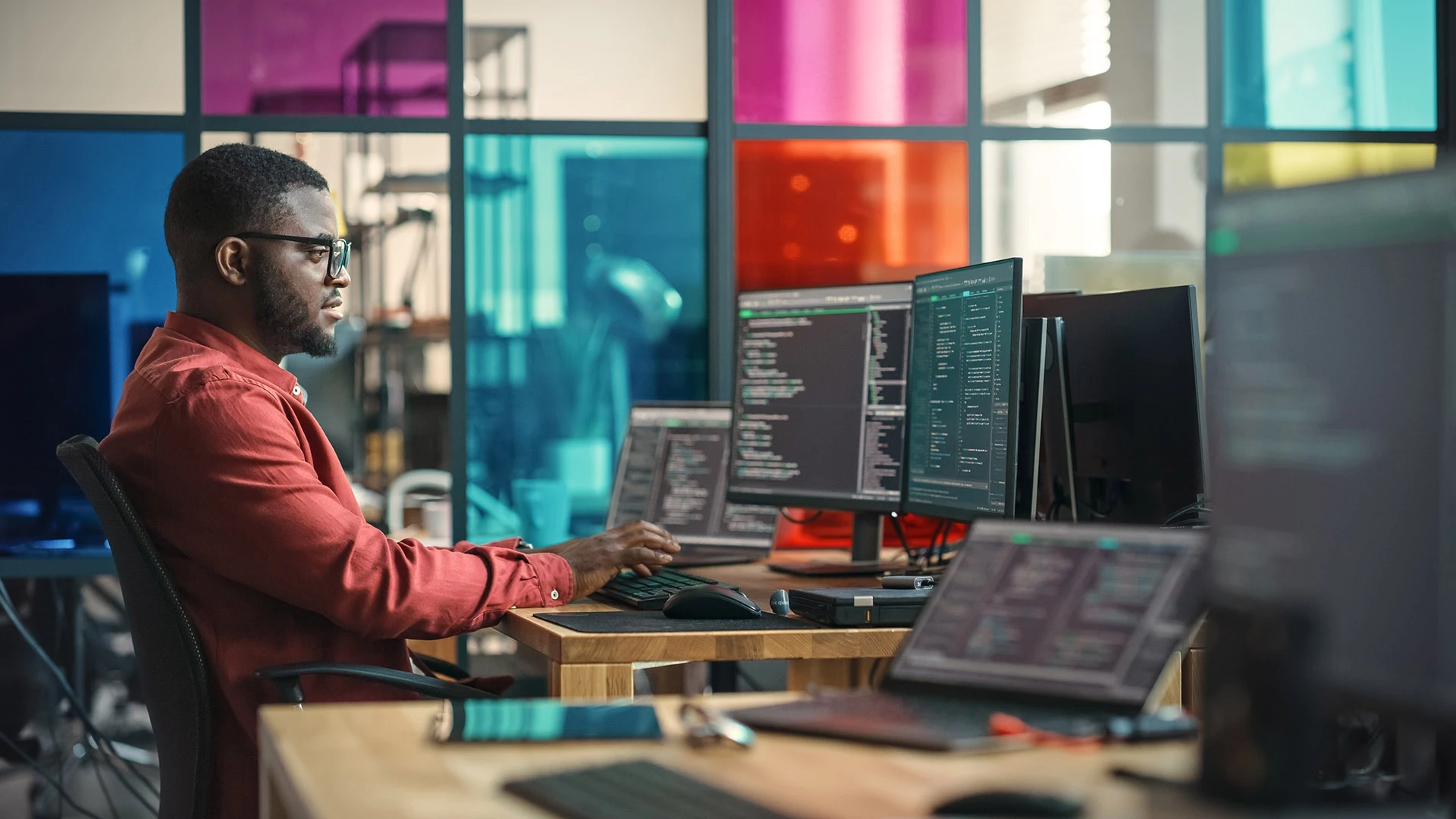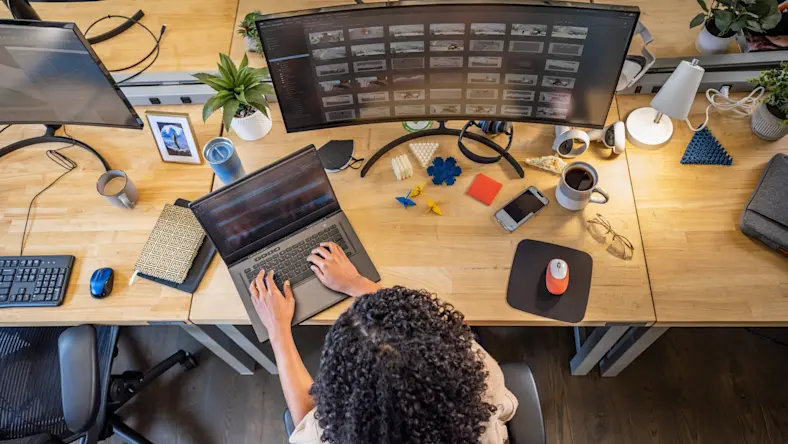& Construction

Integrated BIM tools, including Revit, AutoCAD, and Civil 3D
& Manufacturing

Professional CAD/CAM tools built on Inventor and AutoCAD
Interest in AI is growing at companies around the globe as more and more businesses move forward with AI adoption. Interactive AI chatbots like ChatGPT show the technology’s new applications—and demonstrate the new precision of AI. Though the mechanism has been around for some time, the fluent and natural responses of generative AI can learn data patterns and relationships to generate new content. AI is also advancing in image-generation technology, with a series of new products that create images, videos, 3D models, and more from the text user’s input.
Business leaders are voicing their enthusiasm for artificial intelligence as their companies uncover valuable, industry-specific AI applications. In Autodesk’s global research report 2024 State of Design & Make, 78% of leaders and experts say that AI will enhance their industry and 66% say AI will be “essential across the board” within two to three years. Leaders in the Architecture, Engineering, Construction, and Operations (AECO) industry say that the top uses for AI include increasing productivity (44%), producing informed design options (36%), and identifying product and asset performance gaps (34%).
In Japan, leading general contractors in Japan are beginning to use AI in these varied ways. Obayashi Corporation, a constructor of large-scale global buildings—including the Tokyo Sky Tree, the world’s tallest tower (2,080 feet), and Singapore’s Jewel Changi airport—has been actively using AI in its projects. For example, Obayashi has worked with Autodesk Research to develop an AI platform that lets architects enter building parameters to create volumetric estimates and interior programming layouts.
In 2022, in collaboration with SRI International and Hypar, Obayashi developed AiCorb, a technology that can quickly output multiple building facade designs based on hand-drawn sketches and text descriptions, and then create a 3D model. After conducting a volume study of the land, the proposed facade design is reviewed using AiCorb, and the generated design is integrated and visualized in a 3D model. This process is expected to dramatically accelerate the consensus-building process with the client and reduce the designer’s workload.
AiCorb’s development began in 2017 with the initial question, “Can AI be creative?” Its main focus is proposing various designs from sketches as a generative AI specialized for architectural design. “We trained the AI to read the design intent from detailed sketches and from rough sketches," says Yoshito Tsuji, an architect in the Asia Architectural Design Department of Obayashi's Architectural Design & Engineering Division. “We have prepared multiple AI models, including one that faithfully reads sketches and another that focuses on the quality of the generated results rather than fidelity, so that the tool can be used according to the designer’s intent.”
International construction and engineering firm Shimizu Corporation has also recently announced SYMPREST, an AI that assists in the early design stage of structural study work. This involves studying and setting up structural framing and member cross-sections according to the shape and scale of the building plan. According to Shimizu, SYMPREST will be a digital design method that improves the efficiency of the work, enabling advanced and speedy proposals to developers.
Companies are also taking advantage of the ability to embed a base model AI into a service that connects employees and customers with a proprietary database. An example of this is Microsoft’s Bing AI service, which integrates OpenAI’s GPT-4-base model AI into the Bing search engine with access to Microsoft’s own search database to provide enhanced search results via AI-powered chat.
If companies connect to their databases in this way when using AI, they can draw from their own information in addition to existing information in the base model, which improves the accuracy of AI while protecting confidential information. Kajima, a global construction and real estate development firm, operates Kajima ChatAI, which provides a secure environment for approximately 20,000 employees of various companies by building an in-house equivalent to ChatGPT, where the input information is only used for internal learning. Such examples are increasing among companies in Japan and around the world.
For construction companies, the best way to maximize their collected data is to use BIM (building information modeling) and cloud services—and AI helps deliver even more insights from data. For example, Obayashi Corporation is working on converting images generated by AiCorb into BIM data. “Since BIM data can be assigned the dimensions and materials of each component, we are considering using this data to evaluate various types of performance,” says Takuma Nakabayashi, an AI researcher in the Construction System and Materials Department at Obayashi’s Technology Research Institute. “In the future, we aim to utilize Obayashi’s data to create an AI with a constructability perspective.”
Obayashi has learned a lot from this proactive approach: 70 people have tried the AI about 1,000 times since July 2023, and the company is considering incorporating the AI into the design flow to generate design plans quickly and efficiently. However, “it is difficult to completely control the results generated, and there are both positive and negative opinions about this contingency,” Nakabayashi says. “No matter how much control is gained, it is also important to understand that generative AI has different characteristics from conventional tools such as pens and CAD, which are an extension of the hand.”
When considering the introduction and use of AI, the following three points should be kept in mind. First, consider AI from a corporate perspective.If the purpose of introducing AI as a company is to generate profit and improve productivity, it is necessary to consider how AI fits into the overall workflow. The way the company’s data is used is more important than the AI itself.
Second, be aware that AI will increase some costs. When AI is tasked with a job, the results are immediate and unlimited, but not always accurate. The cost of generation is very low, but as a result, the more you use AI, the more you are forced to review outputs, which can significantly increase costs and reduce productivity. If a company is going to introduce AI, it is necessary to consider how AI can improve productivity and to consider a mechanism to scrutinize the AI’s deliverables.
Finally, even though AI’s accuracy was previously thought to be guaranteed by AI development companies, improving its accuracy depends on what the AI learns from its database. It’s necessary to develop a framework to maintain the company’s database and put it into a form that the AI can use. The key is collecting information into the database and checking its contents on an ongoing basis, which construction companies can achieve by using BIM and cloud services.
For construction companies, connecting AI services to business operations provides a shortcut to insights. Consider a system that allows AI to respond to construction status. To understand the progress on-site, it is necessary to inform AI of the status of the site, which can be reported using a cloud-based BIM platform such as Autodesk Build to track and manage all the assets of a project and the entire lifecycle of equipment. If the data can be visualized by the tool, the accuracy of that reporting can be verified.
The capabilities of AI and the services that use it are constantly changing, and it may not be something that can be started many companies are not able to start using AI immediately. However, the visualization of by using BIM models and cloud-based databases can be carried out regardless of the use of AIservices to collect datafor work in process, . And, by proceeding with this work, it’s possible to create a situation where the you can create a robust database is that will be ready for AI to learn from. The first step toward using AI is deciding how to digitize your company’s information and create a path toward digital transformation.
Shohei Ishikawa is a construction and civil engineering solution engineer and digital transformation specialist at the Technical Sales Division, Autodesk Japan, primarily responsible for cloud solutions in the construction industry. After studying architecture and building engineering at the Tokyo Institute of Technology, Ishikawa worked in the design headquarters of a major general contractor and web application/IoT product development before assuming his current position in 2019.
Executive insights
Executive insights
Executive insights







